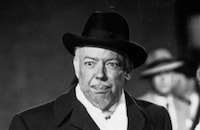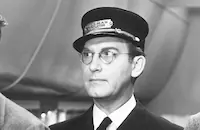The Fuller Brush Man

Brief Synopsis
Cast & Crew
S. Sylvan Simon
Red Skelton
Janet Blair
Don Mcguire
Hillary Brooke
Adele Jergens
Film Details
Technical Specs

Synopsis
When accident-prone street cleaner Red Jones proposes marriage to Ann Elliot, a secretary at the Fuller Brush company, she refuses his engagement ring and tells him that she will not marry him until he makes a success of himself. Ann also tells Red that he should be more like her friend Keenan Wallick, a successful Fuller Brush salesman. Later, Red accidentally causes a trash can fire and is dismissed from his job by Sanitation Commissioner Gordon Trist. To help Red find a new job, Ann arranges to have him tested as a door-to-door Fuller Brush salesman and teams him up with Keenan on one of his runs. Keenan, hoping to get Red out of his way so that he can pursue a romance with Ann, has the inexperienced salesman try out his technique on an "impossible" block. Red fails at his early attempts to sell the brushes, and Keenan, hoping to get rid of Red conclusively, makes a wager, using Ann as the prize, that Red will not be able to sell one single household on a brush. Red next attempts to sell brushes at the home of Commissioner Trist, but he is forcefully ejected from Trist's home when the commissioner realizes that Red is the man whom he fired. Mrs. Trist, however, buys ten brushes from Red. Later, while reporting his sales success to Ann and Keenan, Red realizes that in his excitement he forgot to collect Mrs. Trist's money. When he returns to the Trist estate, Red overhears the commissioner, his business partner, Gregory Cruckston, and others discussing their involvement in a war surplus racket. During the conversation, Sara Franzen, the fiancée of Gordon's son Freddie, tearfully confesses that she is in love with Gordon. Red is caught spying on the family from the garden, and moments after he is brought indoors, the lights go out and Gordon is found stabbed to death. As police lieutenant Quint searches the house for the murder weapon, all those present in the house, including Red, are arrested on suspicion of murder. Though the police initially believe Red to be the killer, he is eventually released for lack of evidence. When Red returns home, he finds Mrs. Trist waiting there. Chaos ensues when Ann arrives, followed by Freddie and two mysterious armed thugs. As the gunmen hold everyone in Red's apartment hostage and search the apartment looking for the murder weapon, Red and Ann discover that the weapon was one of the brushes from the Fuller Brush line, which had been melted and molded into a knife-like object. Before Red and Ann can take their theory to Quint, however, they are trapped by Cruckston, who reveals himself as the murderer. Ann and Red are taken prisoner by Cruckston and his cohorts, but they manage to escape to safety with the help of the police and firemen. With the murderer arrested, Red finally wins Ann's respect, and they embrace and kiss.

Director

S. Sylvan Simon
Cast

Red Skelton

Janet Blair

Don Mcguire

Hillary Brooke

Adele Jergens
Ross Ford
Trudy Marshall

Nicholas Joy

Donald Curtis
Arthur Space
Selmer Jackson

Roger Moore
Stanley Andrews

Bud Wolfe
David Sharpe
Chick Collins
Billy Jones
Jimmy Lloyd
James Logan
Jimmy Hunt
Ann Staunton

Fred Sears
Verna Felton
Garry Owen
Cliff Clark
Kernan Cripps
Mary Field
Alex Melesh
Harry Tyler
Paul E. Burns
Stephen Bennett

Emmett Vogan
Charles Jordan
Virgil Johansen
Rod O'connor
Jack Perrin
Dick Wessel
William Newell

Lee Phelps
Frank Larue
Allen Ray
Dorothy Vernon
Nita Mathews
Nan Holliday
Michael Towne
Frank Mayo
Vivian Mason
Charles Hamilton
Virginia Engels
Joe Gilbert
Judith Woodbury
Mary Bayless
George Hoagland
Abigail Adams
Susan Simon
Ann Burr
Peggy Miller
Crew
Carl Anderson
Ralph Ceder
Al Clark
Lambert Day
Louis Diage
Devery Freeman
Stephen Goossón
Jackson Halliday
Jean Louis
Wilbur Mcgaugh
Wilbur Menefee
Heinz Roemheld
S. Sylvan Simon
Edward Small
Frank Tashlin
Lester White

Film Details
Technical Specs

Articles
The Fuller Brush Man
Skelton made his way to MGM in 1940, and the studio immediately set him to work as comic relief in films such as The People vs. Dr. Kildare (1941). But his first big break came in a remake of a 1933 film called Whistling in the Dark, which Skelton made in 1941 under the same title. His comic timing and snappy dialogue was well received and put Skelton in front of a bigger film audience. The movie's success led to a series of Whistling films, which many fans consider some of his best film work.
The Fuller Brush Man (1948) was produced while Skelton was on loan to Columbia pictures and reunites him with Whistling director S. Sylvan Simon. More auspicious chemistry was supplied by screenwriter Frank Tashlin, (The Girl Can't Help It, 1956 Will Success Spoil Rock Hunter?, 1957).
In the film, Skelton plays eternal underachiever Red Jones, who can't seem to stay out of his own way long enough to win the hand of his sweetheart, Ann (Janet Blair). Red decides he'll take a stab at selling Fuller brushes door-to-door, like Ann's other suitor, Mr. Wallick (Don McGuire). Needless to say, slapstick and misadventure ensue, including a murder case that implicates Red. He emerges victorious, however, after an unforgettable Keystone Cops-like finale that also offers a taste of the satiric humor and surreal slapstick that Tashlin would give full expression to in the next decade.
Though Janet Blair plays Skelton's love interest in The Fuller Brush Man, she was not pleased with her second-fiddle billing and filed suit against Columbia for $250,000, alleging breach of contract because she was entitled to but did not receive equal billing with Skelton.
While Skelton was prolific during his heyday, some believe that Skelton was underutilized by MGM. In his book The Great Movie Comedians, Leonard Maltin suggests that Skelton might have had a more profound film career if he'd started at another studio: "He brought a rare combination of visual and verbal agility to his work that would soon put him in a class by himself. Unfortunately, he wound up at M-G-M, a studio that offered everything money could buy except respect for individual comic genius." In the same book, writer Ross Wetzsteon observes that Skelton's career was a contradictory one, though he made it work for himself: "A mime whose greatest success was on the radio. A folk humorist in the years when American entertainment was becoming urban. A vulgar knockabout at a time when American comedy was becoming sophisticated and verbal. A naïve ne'er-do-well in the age of the self-conscious schlemiel."
Whether Skelton's success was because of or despite his being out-of-sync with prevailing taste is hard to say. But he suffered from a lack of confidence throughout his life as an entertainer. Vincente Minnelli recalls in his autobiography that Skelton was never sure of himself in situation comedy, since so much of his material involved one-liners. "'I'm not funny,' he complained to Edna, then his wife and manager...'You're crazy,' she told him. 'You've never been funnier.' Red proceeded to agonize over all his pervious performances. It was a wonder to him that he'd ever gotten this far."
For most fans, however, there is little question as to why he succeeded. Timeless in his goofy appeal, Red Skelton's brand of comedy continues to delight audiences of all ages.
Producer: S. Sylvan Simon
Director: S. Sylvan Simon
Screenplay: Frank Tashlin, Devery Freeman; Roy Huggins (story)
Cinematography: Lester White
Art Direction: Carl Anderson, Stephen Goosson
Music: Heinz Roemheld
Film Editing: Al Clark
Cast: Red Skelton (Red Jones), Janet Blair (Ann Elliot), Don McGuire (Keenan Wallick), Hillary Brooke (Mildred Trist), Adele Jergens (Miss Sharmley), Ross Ford (Freddie Trist), Trudy Marshall (Sara Franzen), Nicholas Joy (Commissioner Gordon Trist), Donald Curtis (Gregory Cruckston), Arthur Space (Police Lt. Quint).
BW-92m.
by Emily Soares

The Fuller Brush Man
Quotes
Trivia
Notes
According to an April 1948 Hollywood Reporter news item, Columbia chose Hartford, Connecticut, as the site for the film's premiere because it was the home of the Fuller Brush Company. The Fuller Brush Company and its door-to-door salesmen gained in popularity after World War II. An October 1947 New York Times article indicates that S. Sylvan Simon, his wife, and writer Cyrus Rice collaborated on the development of the screen story, and that Simon and actor Red Skelton, who had both been under contract with M-G-M, took their story idea to Columbia after they failed to interest their home studio in the picture. The contribution of Mrs. Simon and Cyrus Rice to the completed film has not been confirmed. The article also indicates that Roy Huggins' short story was not incorporated into the Fuller Brush story until after Edward Small agreed to do the picture. The film marked Skelton's first film away from M-G-M since signing as a contract player many years earlier. According to a pre-production news item in Los Angeles Daily News, Skelton prepared for his role by spending an afternoon selling Fuller Brushes door-to-door.
Although the first Hollywood Reporter production chart listing for the film lists Hal Fisher as the film's art director, subsequent production charts list Carl Anderson. Fisher's contribution to the final film has not been confirmed. A November 1947 Hollywood Reporter news item indicated that A. Howard Fuller, the son of the president of The Fuller Brush Co., was to play himself in the picture, but his appearance in the released film has not been confirmed. In June 1948, according to Hollywood Reporter, actress Janet Blair filed a lawsuit against Edward Small Productions seeking $250,000 in damages for omitting her credit and then placing it in improper type size in some of the film's advertisements and stills. Soon after the suit was filed, a federal judge issued a restraining order preventing Edward Small Productions from issuing any further advertising that did not include Blair's name in the same type size as Skelton's. In 1950, Columbia released a follow-up film to The Fuller Brush Man entitled The Fuller Brush Girl.















